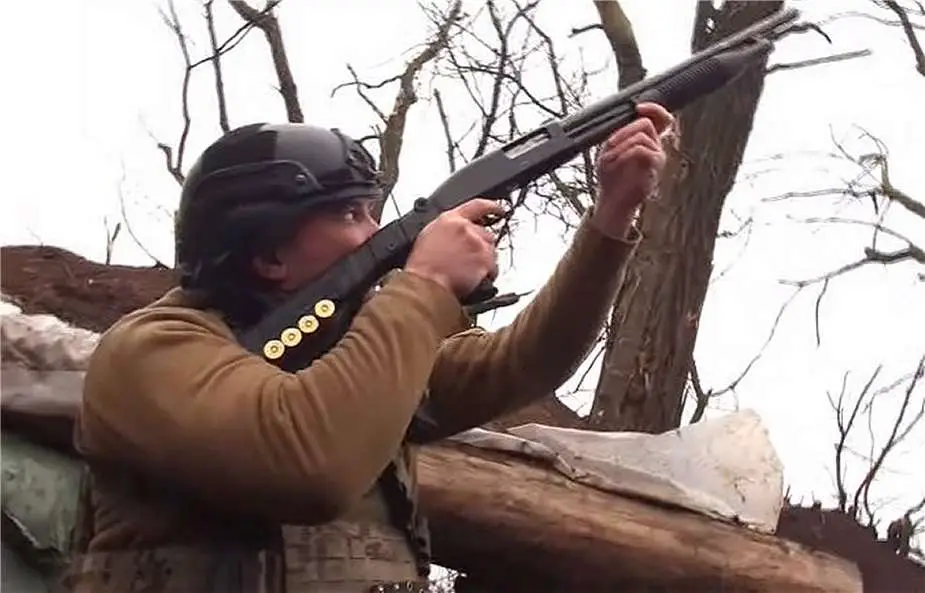Breaking news
Analysis: Shotguns Emerge as a Frontline Defense Against Drones in Evolving Military and Security Tactics.
The growing utilization of shotguns to counter drones represents an intriguing development in modern military and security strategies. This trend underscores the evolving landscape of aerial threats and the pragmatic approaches being adopted to address them. The use of a 12ga 870-pattern shotgun by a member of the 53rd Mechanised Brigade against a Mavic-type drone, along with the Kleine-Brogel Air Base in Belgium's integration of the Benelli M4 Super 90 for drone countermeasures, highlights a shift towards incorporating more accessible and immediate response options against unmanned aerial vehicles (UAVs).
Follow Army Recognition on Google News at this link

A Ukrainian soldier from the 53rd Mechanised Brigade fired a 12ga 870-pattern shotgun at a Mavic-type drone. (Picture source Screen Shot Video footage Youtube)
A shotgun is a long-barreled firearm designed to shoot a wide spread of projectiles called shot. Unlike rifles, which fire a single bullet with each trigger pull, shotguns discharge multiple small pellets, allowing the shooter to hit a broader target area with a single shot. This characteristic makes shotguns particularly effective for hunting birds and small game, as well as for close-range defense and law enforcement applications. Shotguns come in various actions, including pump-action, semi-automatic, and break-action, and are chambered in various gauges, with 12-gauge being the most common due to its balance of power and recoil. The versatility and broad utility of shotguns have made them a staple in both civilian and military arsenals around the world.
The Practicality of Shotguns Against Drones
Shotguns offer several advantages in countering drones, primarily due to their ease of use, widespread availability, and the ability to cover a broad area with a single shot. The pattern spread of a shotgun blast increases the chance of hitting a small, fast-moving target like a drone. This is particularly effective against low-flying or hovering drones, where precision targeting is less critical than the ability to project force over a wide area. Furthermore, the cost-effectiveness of shotguns compared to more sophisticated anti-drone technologies makes them an attractive option for both military and civilian security applications.
Tactical Implications
The tactical shift towards using shotguns reflects an adaptation to the increasing use of drones for surveillance and, in some cases, offensive operations. Drones can offer a low-cost, high-reward tool for reconnaissance, targeting, and even direct attacks, necessitating a practical countermeasure. Shotguns, being relatively simple to operate and maintain, allow for rapid deployment and response to drone threats without the need for extensive training or specialized equipment. This accessibility ensures that a broader range of forces can engage aerial threats, not just specialized units.
Strategic Considerations
The adoption of shotguns for drone defense also signals a broader strategic recognition of the need to counteract the proliferation of UAV technology. As drones become more accessible and capable, the potential for their use in both state and non-state conflict scenarios increases. The decision by the Kleine-Brogel Air Base to publicly announce the integration of the Benelli M4 Super 90 underscores the importance of addressing this threat vector. It reflects a proactive stance in air security, acknowledging that the nature of aerial threats is diversifying and requires a multifaceted response strategy.
Challenges and Limitations
While shotguns provide a practical solution to immediate drone threats, their effectiveness is inherently limited by range and the need for visual contact with the target. This method is less suitable against high-flying or stealthy drones equipped with advanced reconnaissance or attack capabilities. Additionally, the use of shotguns requires considerations of safety and collateral damage, especially in populated areas or near sensitive installations.
In conclusion, the growing use of shotguns to counter drones highlights a pragmatic approach to a rapidly evolving security challenge. It represents a blend of traditional and modern tactics, acknowledging the accessibility and utility of conventional firearms against emerging technological threats. However, as drone technology continues to advance, it will be crucial to integrate such immediate defensive measures with broader anti-drone strategies, including electronic warfare, cyber defense, and advanced detection systems, to ensure comprehensive protection against the diverse array of UAV threats.
Defense News March 2024


























